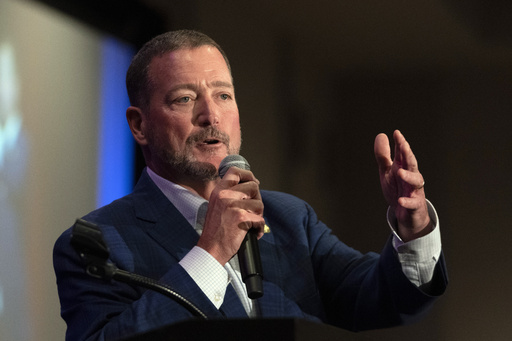From 300,000 cases three decades ago to 11 today.
Those are the numbers that reflect just how close Rotary International, working with a myriad of world health organizations, is to eradicating polio from the planet for good.
The two Columbus-based Rotary clubs are both part of that effort, working locally and globally to help the international cause attain its goal of eradication.
“I think it will happen in my lifetime,” said Roger Brinkman, president of the Columbus Rotary Club, as he talked about the 11 cases that remain in three countries — Pakistan, Nigeria and Afghanistan — and what it will take to completely eradicate the disease, a highly infectious virus that commonly affects children under the age of 5.
[sc:text-divider text-divider-title=”Story continues below gallery” ]
Eradication is defined as having no new cases reported for three to five years, anywhere on Earth.
In preparation for World Polio Day on Oct. 24, the Columbus Rotary Club on Monday invited an Indianapolis Rotary Club member on the front lines of the polio immunization effort to explain how worldwide Rotary International commits to protecting every child.
The Columbus Rotary Club heard from Tim Lee of Indianapolis, one of Rotary’s ambassadors to countries that are still struggling to eradicate polio.
The Columbus Sunrise Rotary Club, which meets Friday mornings, also is involved this month in increasing awareness and raising funds to eradicate polio, club president Priscilla Scalf said. Every meeting this month, Sunrise Rotarian Charlie Dewey has been talking with club members about the importance of the vaccination program and why Rotary is so committed to it, she said.
“One of the things we are trying to do is focus on is the younger generation who have no idea what polio is. They’ve never known anyone to have it in their lifetimes,” Scalf said. “We need to educate them about why Rotary is focusing on this issue.”
Commonly known as poliovirus, the disease is spread person to person, typically through contaminated water. It attacks the nervous system, and may cause paralysis, according to Rotary International. While there is no cure, a vaccine is available, which Rotary and its health care partners have used to immunize more than 2.5 billion children worldwide so far.
Real-life experiences
In a film clip for the Columbus Rotary at Donner Center, Lee took members to Karachi, Pakistan, where he traveled in May representing Rotary International President John Germ, to help immunize children and learn more about the country’s challenges. He has been to Pakistan two other times to work with the effort to immunize all of the country’s youth with polio vaccine.
One of the first interactions Lee recounted from his trip was arriving in the main train station in Karachi and meeting Azmet, a 14-year-old polio survivor abandoned by his family, who now crawls to the train station to beg each day in order to buy food to survive.
“He has no family, no education. This is his life as a polio survivor,” Lee said. “The survivors are left to fend for themselves.”
Lee said he and his wife Amy considered possibly trying to adopt him, but it was unlikely that could happen, he said.
In Pakistan, the number of polio cases continues to fall with the Rotary’s immunization effort, from 306 in 2014 to 20 in 2016, according to Rotary. In 2017, five cases are reported in the country.
In Afghanistan, polio cases have dropped from 28 in 2014 to 13 in 2016, and six this year. Nigeria is reporting zero cases so far this year, down from four in 2016, according to Rotary International.
Lee said Rotarians have donated more than $1 billion over the past 30 years to support polio vaccination, supported by UNICEF, the Centers for Disease Control, the World Health Organization and others. For every dollar donated by Rotarians, the Bill and Melinda Gates Foundation is tripling the donation, up to $50 million a year. Known as the Global Polio Eradication Initiative, Rotary’s part includes advocacy, fundraising, volunteer recruitment and building awareness about the dangers of polio.
Even with only 11 cases left, Rotary says the organization still needs $1.5 billion each year to continue the vaccination effort, as new babies are born every day around the world and require immunization. The 35,000 Rotary Clubs around the world and 1.2 million Rotarians are leading the effort with their health partners to make sure the funding is available for the vaccine, Brinkman said.
Dewey, a Rotarian for 17 years who traveled to Niger in 2006 and Nigeria in 2008 representing the Sunrise club to help immunize children, said he had several reasons for traveling to Africa to support the immunization effort.
“One was to learn how the process worked,” he said. “On the national immunization days, I wanted to support the local people who are doing the immunizations,” he said.
Dewey explained that he also wanted to go overseas in order to bring back the story of the immunization work to local Rotarians, encouraging them to support the international effort.
Not just polio vaccine
The Rotary International Program has a PolioPlus element, launched in 1985, which provides other common childhood immunizations along with the polio vaccine.
While it may sound simple to just immunize all the kids under age 6 in a country, Lee said it isn’t quite that easy.
In Pakistan, for example, the cases are located in an area about the size of Columbus — but there are millions of children in and out of the “hot” area where polio cases have been reported, and more are being born each day, Lee said.
“Just when you think you have everyone vaccinated, you see the logistical problem. People tend to move,” he said.
In Afghanistan, groups attempting to vaccinate children have run into tactical interference by the Taliban, who have told people the vaccine is a CIA plot to sterilize Muslims, which has led to resistance to immunization. Most of the aid workers administering immunizations there are female, as they are allowed into remote homes in the tribal areas of Pakistan and Afghanistan, and there have been workers who have been killed trying to immunize kids, Lee said.
If the disease isn’t totally eradicated, or the immunization effort doesn’t continue at its current rate, as many as 200,000 new cases could occur over the next decade all over the world, Lee said.
“The biggest struggle right now is in India,” Lee said of where immunization continues to be a challenge. “They haven’t had a case in five years, but keeping it that way is a struggle.”
Lee said the vaccine must make its way to the most remote areas of some countries — transported on foot, by bicycle, by camel or on motorcycles.
Lee said administering the oral vaccine to someone is a chance for an ordinary person to have the ability to potentially save a person’s life.
“I’m an engineer, and I don’t really get to do that very often,” he said. “But it’s the idea that we (Rotarians) are involved in something monumental. This could be only the second disease every eradicated (after smallpox),” he said.
[sc:pullout-title pullout-title=”Where to learn more” ][sc:pullout-text-begin]
For information about Rotary International’s efforts to eradicate polio from the planet, visit endpolio.org.
[sc:pullout-text-end][sc:pullout-title pullout-title=”How to help” ][sc:pullout-text-begin]
To donate to the effort to eradicate polio in the world, visit endpolio.org/donate
[sc:pullout-text-end][sc:pullout-title pullout-title=”5 reasons polio needs to be eradicated” ][sc:pullout-text-begin]
1. The human cost: If expectations are to control polio rather than eradicate it, the virus could rebound and cause 200,000 cases annually in the next 10 years.
2. It’s achievable: Vaccines are available and effective enough to end polio, and can reach all children.
3. It’s a good investment: An independent study published in the medical journal Vaccine estimates the return on the global investment in a polio-free world will reach $40 to $50 billion within the next 20 years.
4. It strengthens the system: Polio eradication efforts have established an active global disease surveillance network that is being used for other health interventions, such as measles vaccinations, deworming tablets and mosquito bed nets.
5. It sets the stage: The ability to reach all children with the polio vaccine is proof that the next major global health initiative can also be successful.
Source: endpolio.org
[sc:pullout-text-end][sc:pullout-title pullout-title=”What is polio?” ][sc:pullout-text-begin]
Polio, or poliomyelitis, is a crippling and potentially deadly infectious disease. It is caused by the poliovirus. The virus spreads from person to person and can invade an infected person’s brain and spinal cord, causing paralysis.
Most people who get infected with poliovirus (about 72 out of 100) will not have any visible symptoms. About 1 out of 4 people with poliovirus infection will have flu-like symptoms. These usually last 2 to 5 days then go away on their own.
A smaller proportion of people with poliovirus infection will develop other more serious symptoms that affect the brain and spinal cord:
- Paresthesia (feeling of pins and needles in the legs)
- Meningitis (infection of the covering of the spinal cord and/or brain) occurs in about 1 out of 25 people with poliovirus infection
- Paralysis (can’t move parts of the body) or weakness in the arms, legs, or both, occurs in about 1 out of 200 people with poliovirus infection
Paralysis is the most severe symptom associated with polio because it can lead to permanent disability and death. Between 2 and 10 out of 100 people who have paralysis from poliovirus infection die because the virus affects the muscles that help them breathe.
Even children who seem to fully recover can develop new muscle pain, weakness, or paralysis as adults, 15 to 40 years later. This is called post-polio syndrome.
Poliovirus is contagious. It spreads through contact with the feces of an infected person or droplets from a sneeze or cough. If you get stool or droplets from an infected person on your hands and you touch your mouth, you can get infected. Also, if your child puts objects, such as toys, that have stool or droplets on them into their mouth, they can get infected.
An infected person may spread the virus to others immediately before and usually 1 to 2 weeks after developing symptoms. The virus may live in an infected person’s stool for many weeks. He or she can contaminate food and water when they touch it with unwashed hands.
The United States has been polio-free for more than 30 years, but the disease still occurs in other parts of the world. It would only take one person with polio traveling from another country to bring polio back to the United States.
— Information from the Centers for Disease Control
[sc:pullout-text-end]







